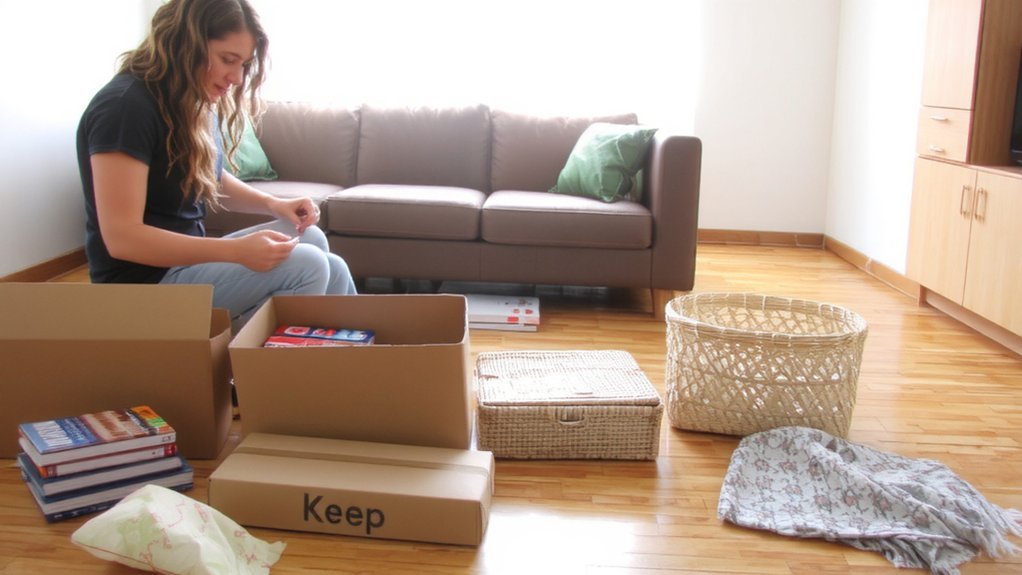You can clear most of your home in a weekend if you work with a simple system, clear priorities, and short focused sprints. Start by staging supplies and setting realistic room goals. Use firm keep/donate/toss rules so you don’t stall on decisions. You’ll want a two‑hour sprint plan and quick donation logistics—keep going to get that step‑by‑step approach.
Set Clear Goals With the S.P.R.I.N.T. Method
When you only have a weekend, vague aims waste time, so set sharp targets with the S.P.R.I.N.T. method.
Start by Scoping: list rooms and prioritize what’ll deliver the biggest impact.
Plan time blocks next, allocating slots for sorting, discarding, and staging items.
Reduce decisions by assigning simple rules: keep, donate, toss.
Identify Resources like boxes, labels, and a trash bag before you begin.
Note Needs—what storage or repairs you’ll postpone—and stick to the weekend’s remit.
Triage quickly: items you haven’t used in a year usually go.
Execute in short bursts, focusing on one task per block and avoiding perfectionism.
Track progress with a checklist and celebrate cleared zones to stay motivated through the sprint.
You’ll finish far more than you expect when you commit.
Choose Your Method: Category Vs Zone
After mapping your sprint blocks and resources, pick the approach that matches your goals: category or zone. If you want fast visual progress and fewer decision points, go category—tackle all clothes, books, or papers across the house. Category work’s efficient for emotional decisions; you’ll quickly see duplicates and priorities.
Choose zone if you need contained wins or rooms are heavily used; focus on one space at a time, finishing surfaces and storage so rooms become functional. You can combine methods: use category for small, scattered items and zone for bulky or room-specific clutter.
Whatever you pick, set simple rules (keep, donate, trash), a timer, and a staging area. Stick to choices—avoid re-circulating items—and you’ll keep momentum. Review quick wins at each break to adjust.
Prep Night and Room-by-Room Schedule
Before you start, spend one prep night gathering supplies (boxes, trash bags, labels, cleaning sprays, a timer), clearing a central staging area, and pre-sorting laundry or anything that’ll slow sprints.
On weekend morning, follow a room-by-room schedule: tackle high-impact zones first — entry, kitchen, and living room — when energy’s highest.
Block two-hour sprints per major room with 15-minute breaks; use 30–45 bursts for bathrooms, closets, and pantries.
Set clear goals: remove trash, relocate misplaced items, and sort keep/donate/store piles.
Snap photos of finished spaces to track progress.
Reserve the final evening to load donations, take out garbage, and do a quick walkthrough to catch missed items before relaxing.
If you stick to the schedule, you’ll finish actionable decluttering and enjoy a truly clearer home by Sunday night.
Decision Rules Based on Attachment Level
Although it can feel hard to let go, use straightforward attachment-based rules to speed decisions: keep items you use regularly or that you genuinely love, keep irreplaceable items with clear long-term purpose, consider photographing and donating sentimental things you rarely see, and toss or recycle things that’re broken, unused, or cause stress.
Next, assess intensity: if an item sparks strong positive feelings, keep it; if it sparks guilt, obligation, or indifference, release it.
Use frequency: daily or weekly use stays, monthly or less goes into a maybe pile.
Set a one-month rule for the maybe pile—if you don’t miss it, it goes.
Apply the one-in-one-out principle for similar items to prevent future buildup.
Trust your rules; they’ll help you make quick, consistent choices daily.
Disposal, Donation, and Next-Step Logistics
When you’ve decided what to release, map out clear next steps for disposal, donation, and recycling so nothing lingers in limbo: schedule pickup times, locate drop-off sites, and bag items by destination.
Label boxes “donate,” “recycle,” or “trash” and keep a running list so nothing gets misplaced.
For valuable or electronic items, check resale platforms or e-waste programs; wipe data and document serial numbers.
Call charities first to confirm needs and pickup rules, and get receipts for tax deductions.
Reserve a vehicle or arrange a pickup service for large items.
Set a firm deadline in your calendar to move each pile; once the day arrives, stick to it.
Follow through immediately to prevent reaccumulation.
Take photos before donating for records and sentimental closure too.
Conclusion
By prepping the night before and using S.P.R.I.N.T you’ll stay focused: scope rooms, prioritize high‑impact areas, run two‑hour sprints with breaks, and use simple keep/donate/toss rules so decisions move fast. Start with entry, kitchen, and living room, sort into labeled piles, photograph anything sentimental, and schedule donations immediately. After pickups and a quick walkthrough, you’ll have a calmer, cleared space—and a plan to keep it that way. Return to this routine monthly to maintain progress.
